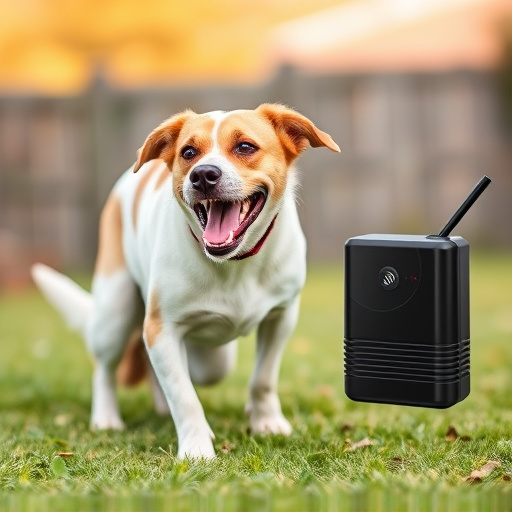Ultrasonic technology offers a humane dog training solution by emitting high-frequency sound waves imperceptible to humans, effectively deterring unwanted behaviors like jumping or excessive barking. Operating at safe power levels, this method promotes positive reinforcement and strengthens the bond between owner and pet, especially for sensitive dogs with anxiety. Strategic placement, consistent use at low power settings, and adjustments based on individual dog responses are crucial for successful and stress-free implementation.
“Discover the revolutionary power of ultrasonic technology in dog training, a safe and effective approach to modifying canine behavior. This innovative method utilizes high-frequency sound waves as a gentle deterrent, without causing harm or fear.
In this comprehensive guide, we explore the science behind ultrasonic dog trainers, their safe power levels, and how they can be used for positive reinforcement. Learn practical tips for implementation and uncover the benefits and considerations of integrating this technology into canine behavior modification programs.”
- Understanding Ultrasonic Technology for Dog Training: A Safe Alternative
- The Science Behind Safe Power Levels and Dog Deterrence
- Implementing Ultrasonic Devices: Tips for Effective and Harmless Training
- Benefits and Considerations for Using Ultrasonic Technology in Canine Behavior Modification
Understanding Ultrasonic Technology for Dog Training: A Safe Alternative
Ultrasonic technology for dog training is a safe and effective alternative to traditional, often intimidating methods. It leverages high-frequency sound waves that are imperceptible to humans but can be used to deter unwanted behaviors in dogs. These sounds operate at safe power levels, ensuring no harm or discomfort comes to your furry friend during the training process.
By emitting ultrasonic tones when a dog exhibits certain behaviors, such as jumping on furniture or barking excessively, the technology gently guides them towards more appropriate alternatives. The sound acts as a subtle but powerful deterrent, allowing dogs to learn and adapt without fear or stress. This method is particularly beneficial for sensitive dogs and those with anxiety, promoting positive reinforcement training that strengthens the bond between owner and pet.
The Science Behind Safe Power Levels and Dog Deterrence
The effectiveness of ultrasonic technology in dog training lies in its ability to deliver safe power levels as a dog deterrent. This innovative approach leverages high-frequency sound waves, imperceptible to humans and most animals, to communicate with dogs. By emitting sounds within a specific range, these devices can capture a dog’s attention without causing any physical harm or discomfort. The science behind it is based on the principle that dogs have a more sensitive hearing range compared to humans, allowing them to perceive and respond to ultrasonic stimuli.
Safe power levels are crucial in ensuring these devices remain humane. They operate at frequencies above 25 kHz, well beyond the range of human detection. When a dog hears the sound, it triggers an innate reaction to avoid the source, thereby deterring unwanted behaviors like barking or jumping on furniture. This method promotes positive reinforcement training by encouraging dogs to associate certain actions with an unpleasant but non-harmful sensation, ultimately shaping their behavior in a safe and effective manner.
Implementing Ultrasonic Devices: Tips for Effective and Harmless Training
Implementing ultrasonic devices for dog training requires a thoughtful and responsible approach to ensure their effectiveness while maintaining safety. These tools emit high-frequency sound waves that are inaudible to humans but can be effectively used as a gentle deterrent. When introducing an ultrasonic device, start with low power settings and gradually increase as needed. Consistency is key; use the device at consistent times during training sessions to establish an association between the sound and desired behavior. Place the device strategically, aiming it at specific behaviors you want to correct, such as jumping or barking excessively.
Remember that safe power levels are crucial for harmless training. Avoid using high settings unless absolutely necessary, as excessive noise can startle or frighten dogs. Always keep in mind that each dog is unique; some may respond more quickly to ultrasonic signals than others. Regularly review and adjust your training methods, ensuring the device remains a helpful tool rather than a source of stress for your canine companion.
Benefits and Considerations for Using Ultrasonic Technology in Canine Behavior Modification
Ultrasonic technology, when used responsibly at safe power levels, offers a promising approach to dog training and behavior modification. This non-vibratory, inaudible sound can serve as an effective dog deterrent, helping to correct unwanted behaviors like barking, jumping, or pulling on leashes without causing physical harm or stress. It works by emitting high-frequency tones that are unpleasant for dogs but generally harmless, encouraging them to change their behavior to avoid the discomfort.
However, it’s crucial to consider the ethics and effectiveness of this method. Not all dogs react the same way to ultrasonic devices, and sensitivity varies based on breed, age, and individual temperament. Proper training and consistent use are essential to ensure the technology is effective and not seen as a last resort or punishment. Additionally, choosing devices with adjustable settings and safe power levels is paramount to avoid unintended consequences and maintain a positive training environment.
Ultrasonic technology offers a safe and effective dog training solution, leveraging safe power levels as a dog deterrent. By understanding the science behind this innovative approach and implementing it properly, owners can successfully modify canine behavior without resorting to harmful methods. As with any training technique, responsible use and consistent application are key. Embracing ultrasonic technology allows for positive reinforcement of desired behaviors, creating a harmonious relationship between pets and their owners.
